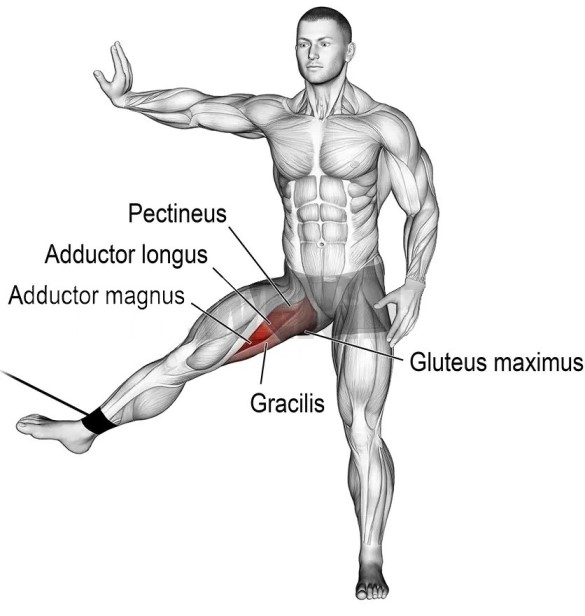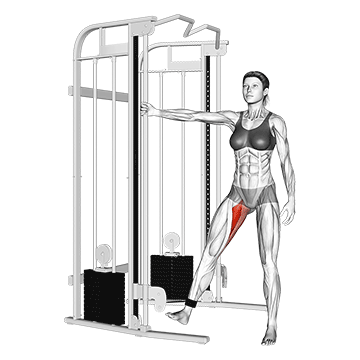Do you crave that sleek, toned inner thigh look? Or are you looking to reduce stress on your knees and hips? Then cable hip adduction is your answer.
In this blog, we’ll discuss the cable hip adduction exercise and how it can transform your lower body strength.

What Is Cable Hip Adduction?
The cable hip adduction is an isolation exercise that targets the hip adductor muscles on the inner thighs, including the adductor magnus, longus, and brevis.
It is performed using a cable machine with an ankle strap attached to one ankle and hooked up to a low cable pulley. You’ll draw your outer leg inward.
Using a cable machine instead of bands or bodyweight allows for constant tension. This provides stability to improve form and works the hip adductors through a larger range of motion than some free-weight alternatives.
Know More: 100+ Leg Workout To Build Mass and Strength
Muscle Worked During Cable Hip Adduction
The primary muscle worked during cable hip adduction is the adductor muscle group, which includes:
- Adductor Magnus
- Adductor Longus
- Adductor Brevis
- Pectineus
- Gracilis
The exercise also engages the piriformis, obliques, and stabilizing leg muscles (quads, hamstrings).

How To Do Standing Hip Adduction With Cable
- Attach an ankle cuff to a low pulley cable machine.
- Stand parallel to the cable machine, ensuring that the leg closest to the pulley is secured with the ankle cuff.
- For balance, you can hold on to the machine or another sturdy object.
- While keeping your leg straight, draw your strapped leg inward across the front of your body.
- Pause at the peak of the movement, squeezing your inner thigh muscles.
- Slowly lower your leg back to the starting position.
- Perform the desired number of repetitions on one leg, then switch and repeat on the other side.

Key Form Tips
- Keep your back straight and avoid leaning away from the machine or towards the weight.
- Keep your working leg straight, with only a slight bend at the knee.
- Focus on a controlled inward and outward movement; don’t swing the weight with momentum.
- Keep your toes pointed forward.
- Keep your abs and oblique muscles active to stabilize your body.
- Stop just before you reach your maximum range of motion; pushing past this might strain your hip joint.
- Don’t hold your breath; remember to exhale as you draw the weight inward and inhale as you lower it.
- Perform an equal number of repetitions on each side to ensure balanced muscle development.
Cable Hip Adduction Alternatives
There are several alternatives to cable hip adduction exercises that effectively target the hip muscles.
- Side-Lying Clam Exercise
- Seated Hip Adduction Machine
- Resistance Band Adduction
- Copenhagen Adductor Plank
- Sumo Squat
- Lateral Walks
- Side-lying hip adduction
- Adductor Squeeze Squat

Manish is a NASM-certified fitness and nutrition coach with over 10 years of experience in weight lifting and fat loss fitness coaching. He specializes in gym-based training and has a lot of knowledge about exercise, lifting technique, biomechanics, and more.
Through “Fit Life Regime,” he generously shares the insights he’s gained over a decade in the field. His goal is to equip others with the knowledge to start their own fitness journey.
